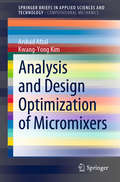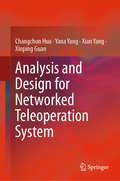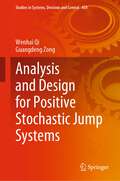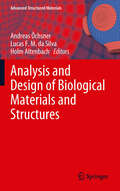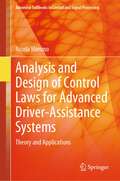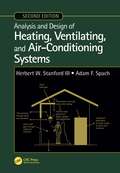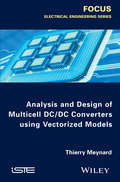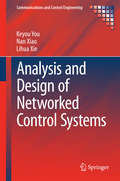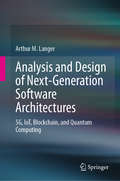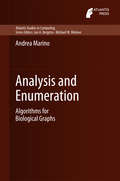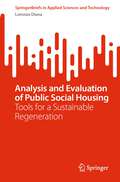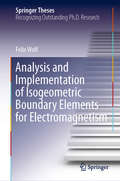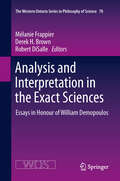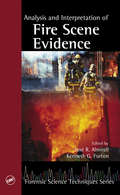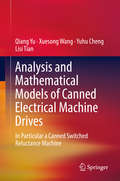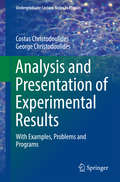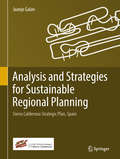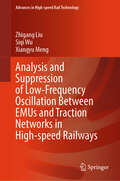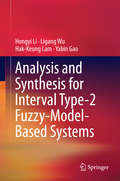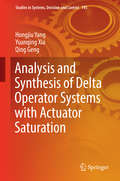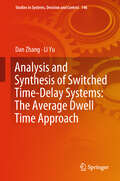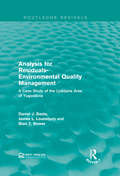- Table View
- List View
Analysis and Design Optimization of Micromixers (SpringerBriefs in Applied Sciences and Technology)
by Kwang-Yong Kim Arshad AfzalThis book illustrates the computational framework based on knowledge of flow and mass transfer together with optimization techniques to solve problems relevant to micromixing technology. The authors provide a detailed analysis of the different numerical techniques applied to the design of micromixers. Flow and mixing analysis is based on both the Eulerian and Lagrangian approaches; relative advantages and disadvantages of the two methods and suitability to different types of mixing problems are analysed. The book also discusses the various facets of numerical schemes subjected to discretization errors and computational grid requirements. Since a large number of studies are based on commercial computational fluid dynamics (CFD) packages, relevant details of these packages to the mixing problem using them are presented. Numerical optimization techniques coupled with CFD analysis of flow and mixing have proved to be an important tool for micromixers design, and therefore, are an important part of the book. These techniques are presented briefly, and focus is on surrogate modeling and optimization applied to design of micromixers.
Analysis and Design for Networked Teleoperation System
by Changchun Hua Xinping Guan Yana Yang Xian YangThis book presents cutting-edge results on stability analysis and control scheme designs for networked teleoperation systems. It highlights new research on commonly encountered nonlinear teleoperation systems, including the stability analysis of teleoperation systems with asymmetric time-varying delays, stability analysis of teleoperation systems with interval time delays, and so on. Moreover, the book presents several high-performance control scheme designs for teleoperation systems when the velocity is available and unavailable, and for systems with nonlinear input. The results presented here mark a substantial contribution to nonlinear teleoperation system theory, robotic control theory and networked control system theory. As such, the book will be of interest to university researchers, R&D engineers and graduate students in control theory and control engineering who wish to learn about the core principles, methods, algorithms, and applications of networked teleoperation systems, robotic systems and nonlinear control systems.
Analysis and Design for Positive Stochastic Jump Systems (Studies in Systems, Decision and Control #450)
by Wenhai Qi Guangdeng ZongThe book focuses on analysis and design for positive stochastic jump systems. By using multiple linear co-positive Lyapunov function method and linear programming technique, a basic theoretical framework is formed toward the issues of analysis and design for positive stochastic jump systems. This is achieved by providing an in-depth study on several major topics such as stability, time delay, finite-time control, observer design, filter design, and fault detection for positive stochastic jump systems. The comprehensive and systematic treatment of positive systems is one of the major features of the book, which is particularly suited for readers who are interested to learn non-negative theory. By reading this book, the reader can obtain the most advanced analysis and design techniques for positive stochastic jump systems.
Analysis and Design of Biological Materials and Structures (Advanced Structured Materials #14)
by Andreas Öchsner Lucas F. Silva Holm AltenbachThis collection provides researchers and scientists with advanced analyses and materials design techniques in Biomaterials and presents mechanical studies of biological structures. In 16 contributions well known experts present their research on Stress and Strain Analysis, Material Properties, Fluid and Gas mechanics and they show related problems.
Analysis and Design of Control Laws for Advanced Driver-Assistance Systems: Theory and Applications (Advanced Textbooks in Control and Signal Processing)
by Nicola MimmoAnalysis and Design of Control Laws for Advanced Driver-Assistance Systems (ADAS) teaches students how to solve classical problems in automotive control in a step-by-step fashion. It begins by motivating the use of ADAS and then explains different ADAS models and the goals of their control systems. Systems analysis and control architectures are presented, followed by a treatment of the use of optimal control and the Kalman filter. The author then presents more advanced control techniques and gives an overview of control problems involved in fully autonomous, hybrid and electric vehicles. Each chapter contains a specific discussion of its subject in terms of various ADAS functionalities, such as active suspension, power steering, lane control and automated parking. The text is developed by extensive use of worked examples, related to the applications discussed. Appendices, including necessary aspects of linear algebra and the use of MATLAB render the text self-contained. MATLAB files are provided to help both student and instructor model and analyse the systems being discussed. An electronic solutions manual is freely available for download by instructors adopting the book for their classroom teaching. This textbook will help final-year undergraduate and graduate students to understand the practical issues they will face when working on automotive systems in the real world and the theoretical underpinnings they will need to get to grips with the control systems of present and future generations of cars and other automotive transport. A basic grounding in mathematics and physics is all that is required to get the most from this text.
Analysis and Design of Heating, Ventilating, and Air-Conditioning Systems, Second Edition
by Herbert W. Stanford III Adam F. SpachAnalysis and Design of Heating, Ventilating, and Air-Conditioning Systems, Second Edition, provides a thorough and modern overview of HVAC for commercial and industrial buildings, emphasizing energy efficiency. This text combines coverage of heating and air conditioning systems design with detailed information on the latest controls technologies. It also addresses the art of HVAC design along with carefully explained scientific and technical content, reflecting the extensive experience of the authors. Modern HVAC topics are addressed, including sustainability, IAQ, water treatment and risk management, vibration and noise mitigation, and maintainability from a practical point of view.
Analysis and Design of Multicell DCDC Converters Using Vectorized Models
by Thierry MeynardShows how the concepts of vectorization and design masks can be used to help the designer in comparing different designs and making the right choices. The book addresses series and parallel multicell conversion directly, and the concepts can be generalized to describe other topologies.
Analysis and Design of Networked Control Systems (Communications and Control Engineering)
by Keyou You Nan Xiao Lihua XieThis monograph focuses on characterizing the stability and performance consequences of inserting limited-capacity communication networks within a control loop. The text shows how integration of the ideas of control and estimation with those of communication and information theory can be used to provide important insights concerning several fundamental problems such as: · minimum data rate for stabilization of linear systems over noisy channels; · minimum network requirement for stabilization of linear systems over fading channels; and · stability of Kalman filtering with intermittent observations. A fundamental link is revealed between the topological entropy of linear dynamical systems and the capacities of communication channels. The design of a logarithmic quantizer for the stabilization of linear systems under various network environments is also extensively discussed and solutions to many problems of Kalman filtering with intermittent observations are demonstrated. Analysis and Design of Networked Control Systems will interest control theorists and engineers working with networked systems and may also be used as a resource for graduate students with backgrounds in applied mathematics, communications or control who are studying such systems.
Analysis and Design of Next-Generation Software Architectures: 5G, IoT, Blockchain, and Quantum Computing
by Arthur M. LangerThis book provides a detailed “how-to” guide, addressing aspects ranging from analysis and design to the implementation of applications, which need to be integrated within legacy applications and databases.The analysis and design of the next generation of software architectures must address the new requirements to accommodate the Internet of things (IoT), cybersecurity, blockchain networks, cloud, and quantum computer technologies. As 5G wireless increasingly establishes itself over the next few years, moving legacy applications into these new architectures will be critical for companies to compete in a consumer-driven and social media-based economy. Few organizations, however, understand the challenges and complexities of moving from a central database legacy architecture to a ledger and networked environment.The challenge is not limited to just designing new software applications. Indeed, the next generation needs to function more independently on various devices, and on more diverse and wireless-centric networks. Furthermore, databases must be broken down into linked list-based blockchain architectures, which will involve analytic decisions regarding which portions of data and metadata will be processed within the chain, and which ones will be dependent on cloud systems. Finally, the collection of all data throughout these vast networks will need to be aggregated and used for predictive analysis across a variety of competitive business applications in a secured environment. Certainly not an easy task for any analyst/designer!Many organizations will continue to use packaged products and open-source applications. These third-party products will need to be integrated into the new architecture paradigms and have seamless data aggregation capabilities, while maintaining the necessary cyber compliances. The book also clearly defines the roles and responsibilities of the stakeholders involved, including the IT departments, users, executive sponsors, and third-party vendors. The book’s structure also provides a step-by-step method to help ensure a higher rate of success in the context of re-engineering existing applications and databases, as well as selecting third-party products, conversion methods and cybercontrols. It was written for use by a broad audience, including IT developers, software engineers, application vendors, business line managers, and executives.
Analysis and Enumeration: Algorithms for Biological Graphs (Atlantis Studies in Computing #6)
by Andrea MarinoIn this work we plan to revise the main techniques for enumeration algorithms and to show four examples of enumeration algorithms that can be applied to efficiently deal with some biological problems modelled by using biological networks: enumerating central and peripheral nodes of a network, enumerating stories, enumerating paths or cycles, and enumerating bubbles. Notice that the corresponding computational problems we define are of more general interest and our results hold in the case of arbitrary graphs. Enumerating all the most and less central vertices in a network according to their eccentricity is an example of an enumeration problem whose solutions are polynomial and can be listed in polynomial time, very often in linear or almost linear time in practice. Enumerating stories, i. e. all maximal directed acyclic subgraphs of a graph G whose sources and targets belong to a predefined subset of the vertices, is on the other hand an example of an enumeration problem with an exponential number of solutions, that can be solved by using a non trivial brute-force approach. Given a metabolic network, each individual story should explain how some interesting metabolites are derived from some others through a chain of reactions, by keeping all alternative pathways between sources and targets. Enumerating cycles or paths in an undirected graph, such as a protein-protein interaction undirected network, is an example of an enumeration problem in which all the solutions can be listed through an optimal algorithm, i. e. the time required to list all the solutions is dominated by the time to read the graph plus the time required to print all of them. By extending this result to directed graphs, it would be possible to deal more efficiently with feedback loops and signed paths analysis in signed or interaction directed graphs, such as gene regulatory networks. Finally, enumerating mouths or bubbles with a source s in a directed graph, that is enumerating all the two vertex-disjoint directed paths between the source s and all the possible targets, is an example of an enumeration problem in which all the solutions can be listed through a linear delay algorithm, meaning that the delay between any two consecutive solutions is linear, by turning the problem into a constrained cycle enumeration problem. Such patterns, in a de Bruijn graph representation of the reads obtained by sequencing, are related to polymorphisms in DNA- or RNA-seq data.
Analysis and Evaluation of Public Social Housing: Tools for a Sustainable Regeneration (SpringerBriefs in Applied Sciences and Technology)
by Lorenzo DianaThe book explores current characteristics of the urban built environment in view of possible future transformations. A cross-reading analysis of existing public social housing buildings is proposed, based on the investigation of their architectural, structural, and energetic characteristics. The study aims to provide an integrated approach that captures the link between typology, construction, and energy demands, offering a key to understanding the main critical issues and transformation readiness. It focuses on large-scale interventions composing public social housing stocks, realized during the second half of the twentieth century. More than other public interventions, such building stocks clearly lack in meeting current housing needs such as modern apartment architectural layout, energy and structural regulations, and social mix. However, due to their numerical presence, strategical and widespread distribution across urban areas, and transformability, these buildings can be the target for future strategic regeneration projects. In particular, the book thoroughly investigates the social housing estate constructed in Rome (Italy) after the approval in 1964 of the first urban economic and social housing plan.
Analysis and Implementation of Isogeometric Boundary Elements for Electromagnetism (Springer Theses)
by Felix WolfThis book presents a comprehensive mathematical and computational approach for solving electromagnetic problems of practical relevance, such as electromagnetic scattering and the cavity problems. After an in-depth introduction to the mathematical foundations of isogeometric analysis, which discusses how to conduct higher-order simulations efficiently and without the introduction of geometrical errors, the book proves quasi-optimal approximation properties for all trace spaces of the de Rham sequence, and demonstrates inf-sup stability of the isogeometric discretisation of the electric field integral equation (EFIE). Theoretical properties and algorithms are described in detail. The algorithmic approach is, in turn, validated through a series of numerical experiments aimed at solving a set of electromagnetic scattering problems. In the last part of the book, the boundary element method is combined with a novel eigenvalue solver, a so-called contour integral method. An algorithm is presented, together with a set of successful numerical experiments, showing that the eigenvalue solver benefits from the high orders of convergence offered by the boundary element approach. Last, the resulting software, called BEMBEL (Boundary Element Method Based Engineering Library), is reviewed: the user interface is presented, while the underlying design considerations are explained in detail. Given its scope, this book bridges an important gap between numerical analysis and engineering design of electromagnetic devices.
Analysis and Interpretation in the Exact Sciences: Essays in Honour of William Demopoulos (The Western Ontario Series in Philosophy of Science #78)
by Robert Disalle Melanie Frappier Derek BrownThe essays in this volume concern the points of intersection between analytic philosophy and the philosophy of the exact sciences. More precisely, it concern connections between knowledge in mathematics and the exact sciences, on the one hand, and the conceptual foundations of knowledge in general. Its guiding idea is that, in contemporary philosophy of science, there are profound problems of theoretical interpretation-- problems that transcend both the methodological concerns of general philosophy of science, and the technical concerns of philosophers of particular sciences. A fruitful approach to these problems combines the study of scientific detail with the kind of conceptual analysis that is characteristic of the modern analytic tradition. Such an approach is shared by these contributors: some primarily known as analytic philosophers, some as philosophers of science, but all deeply aware that the problems of analysis and interpretation link these fields together.
Analysis and Interpretation of Fire Scene Evidence
by José R. Almirall Kenneth G. FurtonOngoing advances in arson detection tools and techniques increase the importance of scientific evidence in related court proceedings. In order to assemble an airtight case, investigators and forensic scientists need a resource that assists them in properly conducting the chemical analysis and interpretation of physical evidence found at scenes of s
Analysis and Mathematical Models of Canned Electrical Machine Drives: In Particular a Canned Switched Reluctance Machine
by Qiang Yu Xuesong Wang Yuhu Cheng Lisi TianThis book focuses on the electromagnetic and thermal modeling and analysis of electrical machines, especially canned electrical machines for hydraulic pump applications. It addresses both the principles and engineering practice, with more weight placed on mathematical modeling and theoretical analysis. This is achieved by providing in-depth studies on a number of major topics such as: can shield effect analysis, machine geometry optimization, control analysis, thermal and electromagnetic network models, magneto motive force modeling, and spatial magnetic field modeling. For the can shield effect analysis, several cases are studied in detail, including classical canned induction machines, as well as state-of-the-art canned permanent magnet machines and switched reluctance machines. The comprehensive and systematic treatment of the can effect for canned electrical machines is one of the major features of this book, which is particularly suited for readers who are interested in learning about electrical machines, especially for hydraulic pumping, deep-sea exploration, mining and the nuclear power industry. The book offers a valuable resource for researchers, engineers, and graduate students in the fields of electrical machines, magnetic and thermal engineering, etc.
Analysis and Modeling of Radio Wave Propagation
by Christopher John ColemanThis comprehensive guide helps readers understand the theory and techniques needed to analyze and model radio wave propagation in complex environments. All of the essential topics are covered, from the fundamental concepts of radio systems, to complex propagation phenomena. These topics include diffraction, ray tracing, scattering, atmospheric ducting, ionospheric ducting, scintillation, and propagation through both urban and non-urban environments. Emphasis is placed on practical procedures, with detailed discussion of numerical and mathematical methods providing readers with the necessary skills to build their own propagation models and develop their own techniques. MATLAB functions illustrating key modeling ideas are provided online. This is an invaluable resource for anyone wanting to use propagation models to understand the performance of radio systems for navigation, radar, communications, or broadcasting.
Analysis and Presentation of Experimental Results: With Examples, Problems and Programs (Undergraduate Lecture Notes in Physics)
by Costas Christodoulides George ChristodoulidesThis book is intended as a guide to the analysis and presentation of experimental results. It develops various techniques for the numerical processing of experimental data, using basic statistical methods and the theory of errors. After presenting basic theoretical concepts, the book describes the methods by which the results can be presented, both numerically and graphically. The book is divided into three parts, of roughly equal length, addressing the theory, the analysis of data, and the presentation of results. Examples are given and problems are solved using the Excel, Origin, Python and R software packages. In addition, programs in all four languages are made available to readers, allowing them to use them in analyzing and presenting the results of their own experiments. Subjects are treated at a level appropriate for undergraduate students in the natural sciences, but this book should also appeal to anyone whose work involves dealing with experimental results.
Analysis and Strategies for Sustainable Regional Planning: Sierra Calderona Strategic Plan, Spain
by Juanjo GalanThe book presents a unique example of integral planning at different scales and across different types of landscapes found on the outskirts of metropolitan areas. It features a sustainability-based plan to improve the evolution of the south-central area of the Calderona Mountain Range, Spain (Sierra Calderona). It is informed and driven by social, cultural, perceptual, sustainability and economic factors supported by a participative process. The plan addresses the frequent conflict between the management of natural and cultural values found in peri-urban areas and the strong pressure for transformation and public use.Incorporating new methodologies and graphical systems for regional and local planning, the plan provides a practical example of balanced and multidisciplinary planning, based on principles of sustainability, systems thinking, new governance and local adaptation. This is volume one of a two-volume series. It elaborates on regional analysis and diagnosis, and on the definition of strategies for the following themes: natural environment, agriculture and livestock farming, urban environment and wellbeing, infrastructures and mobility, cultural heritage, tourism and public use, landscape, sustainability, socio-demography, economic development and governance. The book is intended for planners and researchers from various disciplines, including urban planning, forestry, agriculture, cultural and touristic management, and sustainability studies.
Analysis and Suppression of Low-Frequency Oscillation Between EMUs and Traction Networks in High-speed Railways (Advances in High-speed Rail Technology)
by Zhigang Liu Siqi Wu Xiangyu MengThis book focuses on the low-frequency oscillation between EMUs and traction networks in high-speed Railways. As the power source of high-speed trains, the traction network's power performance directly affects the safe and stable operation of the train. However, the low-frequency oscillation between EMUs and traction networks will fluctuate voltage or current, resulting in poor power quality, electrical device failure, and even interruption of traction power. Therefore, it is important to reveal the mechanism of low-frequency oscillation and propose suppression strategies. This book systematically shows the newest research results of analysis and suppression of low-frequency oscillation between EMUs and traction networks in high-speed railways, especially in the modeling methods of vehicle-grid systems and suppression strategies for low-frequency oscillation. These methods or strategies can provide important references and help for researchers, scholars, and engineers on traction power technology in high-speed railways. The main contents include the overview of low-frequency oscillation between EMUs and traction networks, the introduction of main modeling methods for vehicle-grid systems, especially single-phase rectifiers, the line-side converter control algorithms in vehicles for the suppression of low-frequency oscillation, the traction substation power compensation strategies for the suppression of low-frequency oscillation, etc.
Analysis and Synthesis for Discrete-Time Switched Systems: A Quasi-Time-Dependent Method (Studies in Systems, Decision and Control #244)
by Peng Shi Zhongyang Fei Shuang ShiThis book presents recent theoretical advances in the analysis and synthesis of discrete-time switched systems under the time-dependent switching scheme, including stability and disturbance attenuation performance analysis, control and filtering, asynchronous switching, finite-time analysis and synthesis, and reachable set estimation. It discusses time-scheduled technology, which can achieve a better performance and reduce conservatism compared with the traditional time-independent approach. Serving as a reference resource for researchers and engineers in the system and control community, it is also useful for graduate and undergraduate students interested in switched systems and their applications.
Analysis and Synthesis for Interval Type-2 Fuzzy-Model-Based Systems
by Ligang Wu Hongyi Li Hak-Keung Lam Yabin GaoThis book develops a set of reference methods capable of modeling uncertainties existing in membership functions, and analyzing and synthesizing the interval type-2 fuzzy systems with desired performances. It also provides numerous simulation results for various examples, which fill certain gaps in this area of research and may serve as benchmark solutions for the readers. Interval type-2 T-S fuzzy models provide a convenient and flexible method for analysis and synthesis of complex nonlinear systems with uncertainties.
Analysis and Synthesis of Delta Operator Systems with Actuator Saturation (Studies in Systems, Decision and Control #193)
by Yuanqing Xia Hongjiu Yang Qing GengThis book presents basic research on delta operator systems (DOS) with actuator saturation. It proposes null controllable regions of delta operator systems, introduces the enlarging of the domain of attraction and analyzes the performance of DOSs subject to actuator saturation. It also discusses the domain of attraction on different systems in delta domain, and investigates the applications in complicated systems using delta operator approaches.
Analysis and Synthesis of Switched Time-Delay Systems: The Average Dwell Time Approach (Studies in Systems, Decision and Control #146)
by Dan Zhang Li YuThis book, written by experts in the field, is based on the latest research on the analysis and synthesis of switched time-delay systems. It covers the stability, filtering, fault detection and control problems, which are studied using the average dwell time approach. It presents both the continuous-time and discrete-time systems and provides useful insights and methods, as well as practical algorithms that can be considered in other complex systems, such as neuron networks and genetic regulatory networks, making it a valuable resource for researchers, scientists and engineers in the field of system sciences and control communities.
Analysis einer Veränderlichen: Analytische Funktionen, Differenziation und Integration (Springer-Lehrbuch)
by Uwe Storch Hartmut WiebeLesbar und verständlich trotz einzigartigem Tiefgang.<P> Fördert das Verstehen von Konzepten und Zusammenhängen.<P> Enthält zahlreiche außergewöhnliche Aufgaben und Beispiele.<P>Im Mittelpunkt dieses Lehrbuchs stehen analytische Funktionen sowie Differenziation und Integration von Funktionen einer Veränderlichen. Dabei werden Begriffe wie Stetigkeit und Konvergenz von Folgen und Reihen vorausgesetzt. Der Stoff wird durch zahlreiche Beispiele und Aufgaben illustriert und ergänzt. Das Buch ist zum Selbststudium geeignet, aber vor allem konzipiert als Begleitlektüre von Anfang an für ein Studium der Mathematik, Physik und Informatik. Die stringente Herangehensweise macht es gut lesbar und vergleichsweise leicht verständlich.
Analysis for Residuals-Environmental Quality Management: A Case Study of the Ljubljana Area of Yugoslavia (Routledge Revivals)
by Daniel J. Basta Blair T. Bower James L. LounsburyAccording to the laws of conservation of mass and energy, matter cannot be created or destroyed. Therefore, all human activities result in some residuals. In this title, originally published in 1978, the authors describe the overall magnitude of the annual residuals problem and apply a residuals-environmental quality management (REQM) analysis specifically to the industrial development of the Ljubljana area in the former Yugoslavia. This title is ideal for students interested in environmental studies and international development issues.
